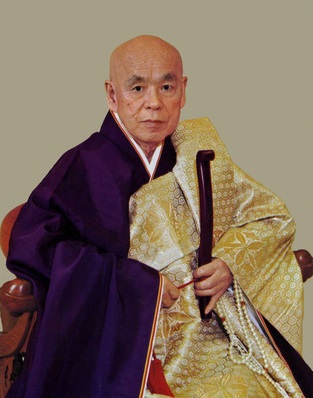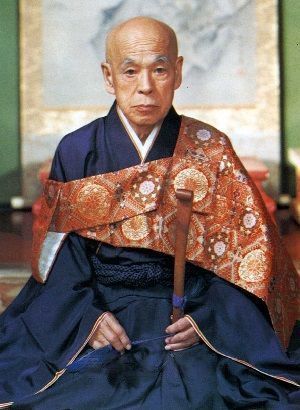ZEN MESTEREK ZEN MASTERS
« Zen főoldal
« vissza a Terebess Online nyitólapjára

秦 (明峰) 慧玉 Hata (Meihō) Egyoku (1896-1985)
The 76th chief abbot of Eihei-ji.
Honorific name: Jigenhukkai Zenji. Dharma transmission from
秦慧昭 Hata Eshō (1862-1944). He also practiced Rinzai Zen in Shogen-ji monastery in Gifu. Zen master with a talent for Chinese poetry.
永平寺七十六世 秦 慧玉禅師
http://eiheizen.jimdo.com/%E6%B0%B8%E5%B9%B3%E5%AF%BA76%E4%B8%96-%E7%A7%A6-%E6%85%A7%E7%8E%89%E7%A6%85%E5%B8%AB/
http://web.kyoto-inet.or.jp/org/jikyu-an/10080.html
http://www.shogaya.com/html-e/hata-egyoku31.htm
秦慧玉禅師法語錄
Hata Egyoku Zenji hō goroku
http://www.worldcat.org/title/hata-egyoku-zenji-hogoroku/oclc/122731423?referer=di&ht=edition
![]()
Hata Egyoku by Ian John Reader
In: Contemporary thought in Soto Zen Buddhism
An investigation of the publications and teachings of the sect in the light of their cultural and historical context.
PhD thesis, University of Leeds. 1983, pp. 374-394.
http://etheses.whiterose.ac.uk/5790/1/uk_bl_ethos_345922.pdf
http://etheses.whiterose.ac.uk/5790/
Abstract
This thesis examines the contemporary thought and themes in the teachings of the Soto Zen Buddhist sect in Japan. It first seeks to draw the parameters within which the sect functions, at the interstices of an historical tradition in Buddhism and a national and religious culture in Japan. The sect has remained within the Mahayana Buddhist mainstream in its assimilation of Japanese traits, and it is this ability to assimilate and adapt that has been at the core of the sect's growth as a Japanese religious sect of Buddhism. This ability to adapt is shown in the modern age and is seen to have had a formative influence on the structure of the sect's belief and teaching for the modern age: this trait is one that has been part of the sect since its very earliest days in Japan. In this context, the contemporary publications of the sect are analysed. An appendix provides a detailed summary of them. Methodological works, aimed at the specialist priesthood, are analysed to show the basic intent of the sect's thinkers, and the aims they espouse. These focus on two areas: those who are members of the sect in a social setting and those who have no interest in the social side of religion but have in the more specialist (e.g.meditational) aspects, and the major themes and ways of talking to these different categories are examined, as are the overriding themes of the sect's publications, such as the failures of modern society(criticised for its materialism)and the decline of traditional feelings of community. The sect's answers are set out, and the possible contradictions between the sect's basic teachings and its social roles are examined, along with the sect's answers and explanations of such discrepancies. It is shown that there are a number of concurrent themes in contemporary so to publications and that these co-exist because the sect seeks to speak to different categories of people at the same time: it is an all-encompassing sect, not one with a rejectionist stance. This diversity, alongside the unity of structure, organisation and teaching, which in themselves are able to accomodate diverse currents, forms the basis of the sect's size and continued stability in Japan's rapidly changing society. The divergent themes within the sect are typified not only by the sect's own imagery but by the writings of some of its leading figures, and a comparison is made of two priests who have held leading positions in the sect, to show this. The conclusion reiterates the theme of unity and diversity, while pointing to possible sources of weakness within the sect's thinking, while suggesting that its history of adaptability provides grounds for believing that the sect will resolve such weaknesses and problems.

The Lineage of 秦 (明峰) 慧玉 Hata (Meihō) Egyoku
永平道元 Eihei Dōgen (1200-1253)
孤雲懐奘 Koun Ejō (1198-1280)
徹通義介 Tettsū Gikai (1219-1309)
螢山紹瑾 Keizan Jōkin (1268-1325)
明峰素哲 Meihō Sotetsu (1277-1350)
珠巌道珍 Shugan Dōchin (?-1387)
徹山旨廓 Tetsuzan Shikaku
慶屋定紹 Kei’oku Teishō (1339–1407)
柏巖樹庭 Hakugan Jutei
玄室智玄 Genshitsu Chigen
東林暾 Tōrin Ton
茂林善榮 Morin Zen’ei
竹堂慧巖 Chikudō Egen
學海性文 Gakukai Shōbun
天怡道悅 Ten’i Do’etsu
怡山文悅 Gisan Mon’etsu
育翁道養 Iku’ō Dōyō
通山慧馨 Tsūzan Ekei
快壽山悅 Gaiju San’etsu
朝山永暾 Chōzan Eiton
謙巖寂英 Kengan Jaku’ei
玉巖懶牛 Gyokugan Raigyū
朝雲喝宗 Chō’un Katsusō
雷洲大震 Raishū Daishin
單山良傳 Tanzan Ryōden
機外默禪 Kigai Mokuzen
默淵慧安 Mokuen E’an
太梅慧芳 Taibai Ehō
默道慧昭 Mokudō Esshō (秦 Hata, 1862-1944)
明峰慧玉 Meihō Egyoku (秦 Hata, 1896-1985)